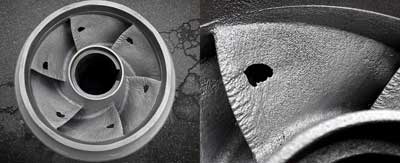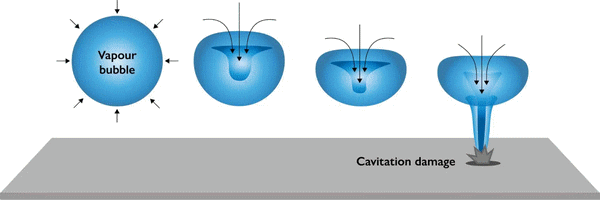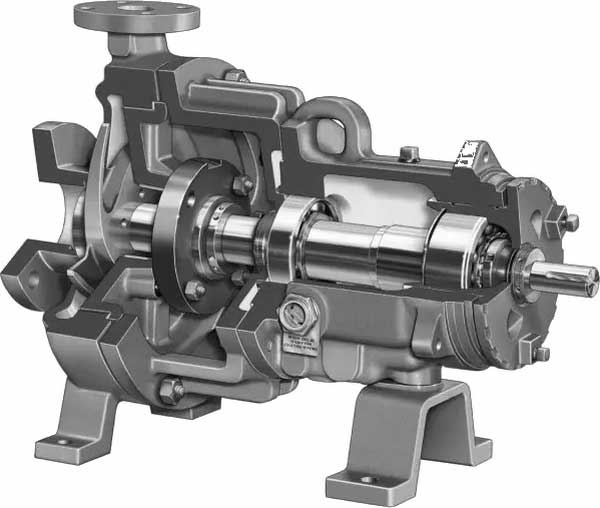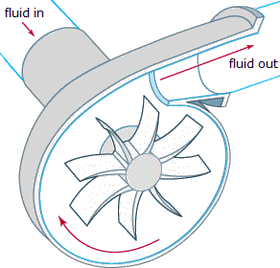What causes pump cavitation and how to avoid it?
Cavitation in pumps is the rapid creation and subsequent disintegration of bubbles in a liquid. Bubbles may not seem very powerful, but the types of bubbles in pumping systems arise from pressure changes and collapse into each other, creating shock waves that occur over and over again, and the repeated shocks erode the parts.
In many cases, the force of cavitation is strong enough to puncture metal parts of the pump, such as the impeller, and damage pump seals.

Image.. www.pumpsandsystems.com
Why does cavitation occur in pumps?
Pumps are designed to operate with a fully flowing fluid inlet, but in some cases a flooded inlet is not sufficient to maintain the pressure needed to prevent cavitation. The inlet or suction side of a pump is the point of lowest pressure in a given pump. In positive displacement pumps, the lowest pressure occurs just before the rotor mesh; in centrifugal pumps, the lowest pressure is at the eye of the impeller.
Cavitation is possible in all pump types, and because the principles are essentially the same, this article focuses on centrifugal pumps. The eye is where fluid is drawn into the impeller and where the rotation of the impeller begins to act on the fluid. When the pressure acting on the fluid is too low, bubbles form and when the fluid accelerates due to the rotation of the impeller, the pressure increases and the bubbles collapse.
Under normal atmospheric pressure, liquids have a predictable vapor pressure. When the pressure in the pump drops below the vapor pressure of the liquid, bubbles form. The bubbles collapse when they reach parts of the fluid where the pressure is above the vapor pressure. In the case of cavitation, this formation and collapse is both rapid and violent. Disrupted or poorly executed processing lines can cause the suction or discharge pressure to drop, leading to cavitation.
POOR CONDITION PUMP INLET
Flow interruptions can have a variety of causes, from system design to component degradation. Common causes of flow interruption that result in cavitation..
- Clogged inlet
- Poorly specified pump
- Inlet lines that are too long
- Clogged filters and strainers
- Restricted or collapsed inlet hoses
- Higher fluid viscosity than expected
DISCHARGE CAVITATION
At extremely high discharge pressure, some of the fluid circulates in the pump instead of being discharged. Fluid trapped between impeller and casing at very high velocity causes a drop in pressure and creates the same conditions as suction cavitation.

New Pump Casing (Right)
Image.. A-L-Lequipment.com
Recognizing Cavitation in a Pump - Cavitation sounds like marbles or gravel circulating through the pump, pipes or hoses. The effects of prolonged cavitation are visible on the pump impeller and other parts.
Typical indications of cavitation include: noise, vibration, faulty seal and or bearings, impeller erosion, higher than normal power consumption.
HOW TO PREVENT PUMP CAVITATION
Start by identifying the cause of the pressure drop. In many cases, the problem can be corrected by moving the pump closer to the fluid source and removing as many bends and valves as possible, as each component causes additional pressure drop. If the suction head is too high to maintain pressure, move the pump closer to the fluid source or place the fluid source closer to the pump.
Enlarging the suction lines can also be effective. In some obvious cases, a blockage occurs in pipes or hoses near the pump. Remove these blockages to solve the problem. Clean suction lines by removing debris. Avoid blowing dirt back to the fluid source as it will likely cause another blockage.
Do not exceed the pump manufacturer's performance guidelines. Pump curves indicate how much positive net suction head the pump requires, so check your pump's performance curve to make sure it has the correct specifications for your application.
Appropriate pressure
Maintaining appropriate pressure levels in the pump system is essential to prevent cavitation. Ensuring that the pump operates within the designated pressure range can prevent situations where the pressure at the inlet falls below the vapor pressure of the fluid.
This can be achieved through proper system design, including the use of pressure relief valves, throttling valves and pressure sensors to control and monitor system pressure levels.

Inlet improvements
Optimizing the inlet conditions is critical to preventing cavitation on the suction side of the pump. This involves implementing strategies to maintain a sufficiently positive net suction head (NPSH) and minimize air entrainment.
Proper design of the intake lines, with sufficient diameter and length, ensures smooth and even fluid flow to the pump, reducing the risk of pressure losses and cavitation.
Installing inlet devices such as vortex breakers and filters can also help improve flow stability and remove entrained air, further reducing the risk of cavitation.
Fluid management
Effectively managing fluid properties can significantly reduce the risk of cavitation occurring. Controlling temperature to keep the fluid within its operating range helps to regulate vapor pressure and minimize the risk of cavitation.
Measures such as filtration and degassing can also help remove impurities and trapped air from the fluid, improving resistance to cavitation.
Finally, adjusting fluid viscosity through additives or temperature control can also reduce cavitation effects by changing the behavior of the fluid under varying operating conditions.

Proper pump selection
Engineers must carefully consider factors such as flow rate, head, fluid characteristics and operating conditions when selecting a pump.
It is essential to ensure that the selected pump can operate within the specified pressure and flow range without exceeding the vapor pressure of the fluid.
In addition, choosing pumps with robust design features and materials resistant to cavitation damage can further improve system reliability and service life.
Related Post(s)

Centrifugal Pumps has been designed specially for use in the food, dairy, beverage, pharmaceutical and light chemical industries...